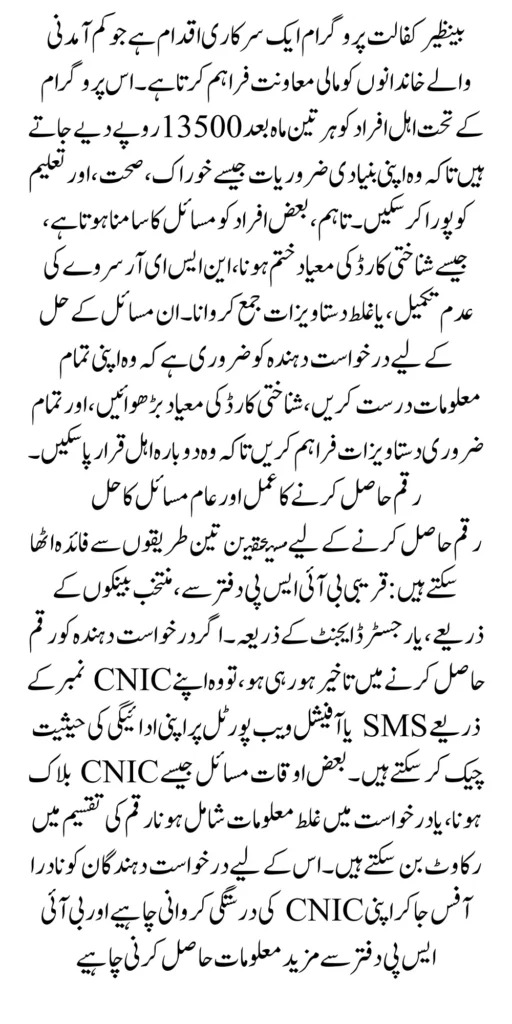BISP Payment 13500 Distribution Process: Common Issues in 2025 Latest Update
The Benazir Income Support Program (BISP) is a vital initiative that provides financial assistance to low-income families across Pakistan. Many beneficiaries of the program receive a quarterly payment of PKR 13,500 to help them meet their basic needs. However, challenges in the registration and payment process can delay or complicate the disbursement of these funds. Here, we explore the BISP Payment 13,500 distribution process, common issues, and how to resolve them.
What is the Benazir Income Support Program (BISP)?
BISP is a government-led program aimed at alleviating poverty and supporting underprivileged families. It prioritizes women, especially female heads of households, to ensure they have access to essential resources such as food, healthcare, and education.
Key Benefits of BISP:
- Financial aid of PKR 13,500 every quarter.
- Educational support for children to attend school.
- Health insurance and other essential benefits.
- Special grants for elderly citizens and individuals with disabilities.
The program’s primary goal is to uplift economically disadvantaged families, enabling them to improve their quality of life. With this aid, families can address basic needs and invest in their children’s future.

BISP Payment 13,500 Distribution Process
If you are eligible for the BISP program, understanding the distribution process is essential to ensure a smooth experience. Below is a step-by-step guide:
1. Eligibility Check
The first step involves confirming eligibility. Applicants must meet specific criteria, including:
- Being part of a low-income household.
- Priority given to women, particularly female heads of households.
Required Documents:
- Valid CNIC (Computerized National Identity Card).
- Proof of income or residence.
2. Application Submission
Once eligible, the next step is to apply through the BISP official website or a nearby BISP registration center. Applicants must provide:
- CNIC of the applicant.
- Proof of income (e.g., utility bills or family registration certificate).
- Any additional documents requested by BISP.
Ensure all information is accurate to avoid disqualification. Incorrect or missing details can delay the process.
3. Registration Confirmation
After submitting your application, BISP verifies the provided details. Upon successful verification, you will receive confirmation via SMS, along with instructions for accessing your benefits. Beneficiaries can also check their status on the BISP portal.
4. Payment Collection Methods
BISP payments are disbursed through the following channels:
- Campsites: Visit designated campsites for thumb verification and payment collection.
- Partner Banks: Payments can be collected from specified banks.
- Registered Agents: Authorized agents provide an easy alternative for receiving funds.
Beneficiaries must ensure their contact details are up-to-date to receive timely notifications about payment schedules and collection points.
Common Issues During the BISP Payment Process
While the program aims to provide seamless support, beneficiaries often face challenges. Here are the most common issues and their solutions:
1. Missing or Expired CNIC
One of the leading causes of payment delays is an invalid or expired CNIC. Ensure your CNIC is valid and matches the information provided in your application.
Solution:
Visit your nearest NADRA office to renew or correct your CNIC details.
2. Incomplete NSER Survey
Applicants not listed in the National Socio-Economic Registry (NSER) database may face disqualification.
Solution:
Complete the NSER survey at designated centers to update your records.
3. Unverified Income Proof
Failure to provide adequate proof of income can result in application rejection.
Solution:
Attach relevant documents such as utility bills, a family registration certificate, or other official income proofs during application.
4. Payment Delays
Technical glitches or administrative backlogs can cause delays in disbursing payments.
Solution:
Regularly check the BISP portal for updates or visit your nearest BISP office for assistance.
5. Incorrect Contact Information
Beneficiaries may miss critical updates if their contact details are outdated.
Solution:
Ensure your phone number and address are updated in the BISP database.
How to Resolve Disqualification Issues
If your application is disqualified, follow these steps to resolve the issue:
- Review the reasons for disqualification.
- Update missing or incorrect documents.
- Reapply through the official BISP channels.
- Ensure all information is accurate and up-to-date.
Important Updates for 2025
BISP has introduced new measures to streamline the payment process and reduce fraud:
- Enhanced verification procedures to ensure only eligible families receive benefits.
- Updated registration forms available on the official website.
- SMS alerts to notify beneficiaries of payment schedules and collection points.
Conclusion
The BISP Payment 13,500 program is a lifeline for many low-income families in Pakistan. By understanding the distribution process, addressing common issues, and staying updated on the latest developments, beneficiaries can ensure they receive timely and hassle-free payments. For more details and updates, visit the official BISP website or sportsdesignss.com for comprehensive guides and resources.
